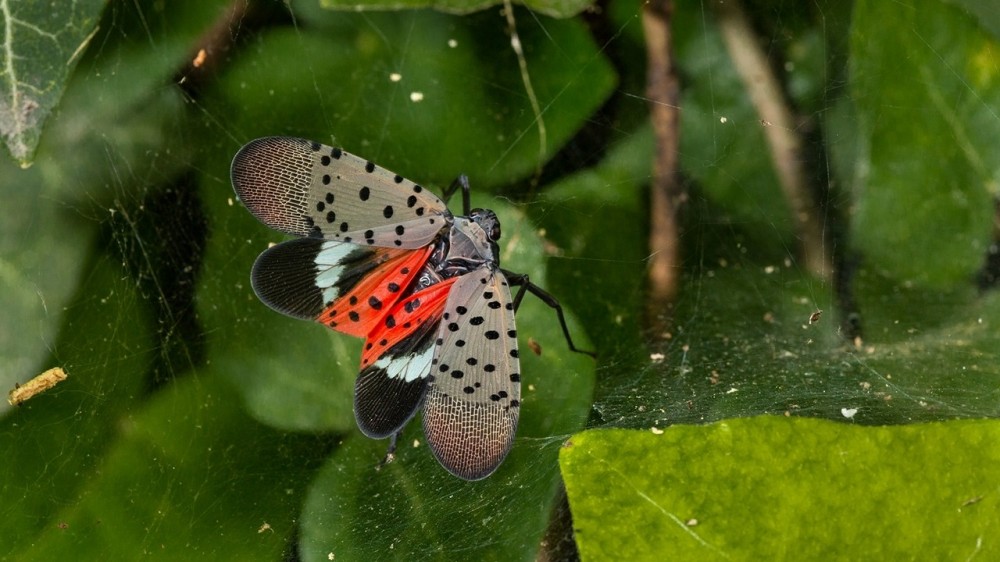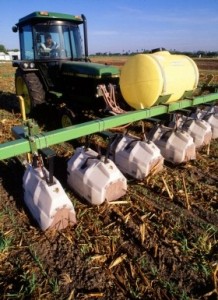Spotted lanternfly (Lycorma delicatula) is an invasive planthopper that feeds on a wide range of plants, including grapes, hops, stone fruits, and hardwood trees. When the spotted lanternfly feeds, it excretes a sticky, sugary fluid that causes sooty mold, which can further damage plants. Its preferred host is tree of heaven (Ailanthus altissima), and today 18 States have some degree of infestation.
The spotted lanternfly is a hitchhiking pest that is native to Asia. It lays its eggs on any hard surface including grills, vehicles, trailers, firewood, outdoor furniture, bikes and toys. The pest was first detected in 2014 in Pennsylvania. It likely arrived in the United States on goods shipped from overseas.
The spotted lanternfly can harm our fruit and forest industries. Early detection is a critical step to mitigating economic and ecological losses. Residents in SLF quarantine areas should check outdoor items before traveling to new areas. Here's what to look for (2.75 MB):
- Appearance
- Nymphs (juvenile spotted lanternflies) are black with white spots and turn red as they develop.
- Adults, roughly 1-inch long and 1/2-inch wide, have a yellow, black-barred abdomen. With large, visually striking wings, adult spotted lanternflies can be easier to spot than other pests. They have brown forewings with black spots at the front and a speckled band at the rear. Their hind wings are scarlet with black spots at the front and white and black bars at the rear.
- Eggs
- Newly laid egg masses (holding 30-50 eggs) resemble wet, gray putty before turning dull and brown, mirroring a smear of cracked mud. The 1-inch long egg masses can be seen in fall, winter, and spring on a variety of smooth surfaces, such as trees, bricks, stones, fences, grills, equipment, and vehicles.
- Newly laid egg masses (holding 30-50 eggs) resemble wet, gray putty before turning dull and brown, mirroring a smear of cracked mud. The 1-inch long egg masses can be seen in fall, winter, and spring on a variety of smooth surfaces, such as trees, bricks, stones, fences, grills, equipment, and vehicles.
- Oozing sap
- When spotted lanternflies feed on plants, they leave behind a sticky, oozing residue called honeydew. This substance attracts other insects, causes mold growth, and further hurts plants.
- Fermented odor
- As honeydew ferments, it can develop an intense, rotten smell.
- Tree-of-heaven
- One of the best places to look for these pests is on a tree-of-heaven, a favorite plant for spotted lanternflies. The tree has a cantaloupe-like texture, with bark that appears light brown to gray. The leaves are large, 1 to 4 feet in length. These leaves are made up of many smaller leaflets on both sides of a central stem.
- Habits
- Spotted lanternflies (both nymphs and adults) frequently gather in large numbers when feeding. They're easiest to spot at dusk or at night as they migrate up and down the trunk of a plant. During the day, they tend to cluster near the base or canopy of a plant, making them more difficult to see.
You can stop the spotted lanternfly from overtaking plants:
- Regular Checks: Inspect your trees and plants for signs of this pest, particularly at dusk and at night when the insects tend to gather in large groups on trunks and stems.
- Close Car Windows: Spotted lanternflies and their nymphs can enter vehicles unsuspectedly. When parked, make sure to keep windows closed. If possible, try to park 15 feet away from trees in a quarantine zone.
- Check Your Vehicle: Before leaving a parking lot or work site, inspect vehicles for eggs or insects. Check doors, sides, bumpers, wheel wells, grills, and roofs. If found, destroy any eggs or insects you find.
- Winter Prep: When preparing for winter, check your outdoor items for egg masses, including items you may bring indoors.
- Destroy Eggs: Look for egg masses in your trees (in particular, tree-of-heaven), bricks, stones, and other smooth surfaces. If you find eggs, smash them (325.72 KB) and scrape them into a plastic zippered bag filled with hand sanitizer or rubbing alcohol to kill them. Then, zip the bag shut and dispose of it in the trash.
- Know Your Zones: If you're traveling through a quarantine area, thoroughly check your vehicle and clothes to avoid moving the pest from a quarantine area to your land and other locations.
- Inspect Items Being Moved: If your business involves moving items, check shipping containers, propane tanks, pallets, and other items being stored outdoors before they're moved offsite. Inspect incoming goods for egg masses and insects.










